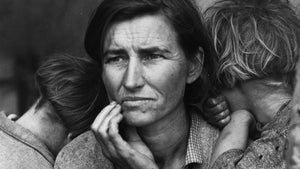Depression Era Documentary photography
Essay by Dan Kosmayer | Walker Evans / Let Us Now Praise Famous Men
The purpose of this essay is to evaluate Walker Evans’ realistic depiction of the rural poor and migrant farmers during the Depression, and how this body of work re-defined the standards of documentary photography. In order to fully grasp the influences of Evan’s powerful imagery, it is necessary to understand the circumstances he was working under. With an understanding of the environmental influences, this essay will compare differences between his photography and other photographers during this period. President Roosevelt established the Resettlement Administration (RA) in 1935 to document and elevate the plight of rural American farmers (renamed Farm Security Administration (FSA) in 1937.) Roosevelt appointed Rexford Tugwell to implement their ‘New Deal’ that focused on relief, reform, and recovery. Tugwell, however, found it difficult to convince Congress to pass the necessary legislation. Tugwell turned to a former colleague, economist and photographer, Roy Stryker to help people understand the plight of the rural farmer. During Stryker’s tenure at Columbia University, he used photography to help his students better understand economics. Tugwell wanted Stryker to educate the public, through photography, on what it was like to be a farmer during the Depression. Thus, in 1935, Stryker joined the Roosevelt administration as ‘Head of the History Section’. Stryker’s goal would see the work of the History Section document American life and events. He wanted to create a body of work that would last for future generations.

His first task was to assemble a team of photographers. Roy Stryker assembled photographers that included Walker Evans, Dorothea Lange, Russell Lee, John Collier Jr., Edwin Rosskam, Jack Delano, Gordon Parks, John Vachon, Marion Post Wolcott, Arthur Rothstein, and Carl Mydans. The qualities he was looking for were photographers that had studied photography as an art form or journalism. He believed that they understood the power of photography as a tool of puersuasion.1 Stryker wanted to capitalize on the cultural popularity of “picture-taking” and photojournalism that was taking place during the 1930’s.2 The purpose of any documentary photography or photojournalism is to record the importance in the subject in order to portray a true sense of the event or theme. You could argue that ‘documentary’ photographs must show all aspects and points of view, not simply the ones chosen by the photographer or editor to further ones objective or conclusion. However, when the FSA sent photographers around the country to compile and document information of the FSA’s relief efforts, they did so with the primary goal of impressing upon Congress and the American people the need for the ‘New Deal’ and its government aid programs. These photos were meant to sway members of Congress and the American people by making them aware of the devastation for the farm communities in the South and Midwest. As such, Stryker maintained strict control over this team, and what should or should not be depicted in the photographs. Stryker wanted photographs there were future oriented and “showed a determination that not even the Depression could kill.” 3 He wanted photographs to show the American people that the New Deal would create a ‘better future’ for the farmers and rural poor. The following photographs by Russell Lee, Jack Delano, and Marion Post Wolcott show examples of the type of work Stryker’s envisioned.

The image Spanish American Workers by Russell Lee exemplifies the “future-orientation” that the FSA wanted. They wanted to prove to the public that its relief programs were working. Lee’s image showing workers building a new home portrays progress and hope for the future.
The photo by Jack Delano shows Connecticut Polish farmers in a joyful mood despite the poverty and depression that has devastated their farm. Delano’s image portrays hope and prosperity for the future as a result of FSA program, which was exactly what Stryker envisioned.

The Photograph of Miss Wilkins making biscuits for dinner is another example by photographer Marion Post Wolcott conveying the message of how the FSA funding is restoring life to normal. What is more comforting that a photograph of mom in the kitchen baking for her family? Notice the abundance of food, and even the flowers on the shelf. Stryker wanted the images to show the American people that hope existed for the future with the FSA programs. Walker Evans, however, believed that the images must be a “pure record and not propaganda”.4 Evans wanted to create images that were more than just the FSA. Evans despised the political nature of the project and was determined to maintain his independence. By departing from the political agenda of the FSA he was able to create a sense of realism. Although Stryker admired Evans’ photographs, the two men did not get along. The conflict between Evans beliefs of creating a pure objective record, and the FSA’s political and social agenda, resulted in Stryker letting Evans go in 1937. Even though Evans’ tenure was a mere 18 months, he created some of the most powerful documentary images in America. Using the imagery created for the FSA project, and in collaboration with James Agree, they published the landmark book Let Us Now Praise Famous Men in 1941. This book was the result of the material gathered during an assignment the men accepted in 1936 for Fortune magazine.

They were to produce an article documenting the lives of sharecropper families in the cotton belt. With this assignment, Agee and Evans set out for the South with the best of intentions. They would be respectful to the farmers, but they did not intend to cater their assignment into Stryker’s propaganda agenda. At first the southern tenant farmers met the two New York journalists with suspicion. But after a month long search, they were successful in persuading Burroughs, the Tengle, and the Fields families from Alabama to take part in their assignment (they were given pseudonyms in the book to conceal their identity). Both Evans and Agree lived with the families for several weeks and recorded their experience of ‘their world’, and did so with respect and dignity. For this privilege they pair the families room and board.5 The following images from Evan’s Let Us Now Praise Famous Men photo essay juxtaposed against the images by Lee, Delano, and Wolcott, illustrate where Evan’s departed from other photographers who complied to Stryker’s objectives.

The photo of the Fields family portrays the reality as he saw them. There is poverty, struggle and hardship. Evan’s used an 8×10 view camera and had the family pose for the photograph. Even though he composed the image, he did not attempt to hide that the reality was not rosy. They could not look forward to the future; the present struggles did not afford them that luxury. The most daunting aspect of this photo is the stare of the elder child – there is no innocence one would expect from someone so young, just the harsh reality of their life as it is in the present.
Evans made four pictures of Allie Mae Burroughs. One of the most popular images from the book is the one depicting brooding anger and resentment, conveyed by a slight tilt of the head, the furrows around the eyes, the angle of the pursed mouth.6 There is no contrived smile conjured up for the photograph. She is frail but yet her eyes portray the cold reality that life is not easy and she must be strong. She folds her lips as if she is holding back real story of her life. Jeff Allred describes the image as a rendering of the human figure; rooted and emplaced entity is reinforced in the photograph by the visual rhyme linking the severe horizontality of the wrinkles and the hair to the grain of the clapboards of her home. Evans’s camera captures a reaction in which an instant of the ordinary life is translated faithfully.7
The portrait of Lucille Burroughs reminds one that the realities of the depression are not limited to the adults. Despite attempts to dress as a young girl, the facial expression tells a story more sober than a young child should face.

The photograph of the child’s’ grave illustrates how Evan’s observes a subject and records it. He photographed it just as one would if they walked up to the grave. The site is undisturbed and no markings are visible to indentify the deceased child. There are no clues as to what happened to the child. One can only conceptualize the harsh environment and dangers endured by the cotton farmers during the depression. Evan’s imagery was successful because he photographed how he ‘saw’ the world in the present. His photographs have a realistic and objective quality. He felt as if the images should tell a story in itself. Hence, placing his entire image collection at the beginning of the Let Us Now Praise Famous Men book before the title page, without any text commentary, plate numbers, or any other way to match them with the subjects and scenes described by Agee – a departure from the standard practice of photojournalism where photos are used to support the written article.8 The images were meant to stand-alone and tell a story. Although Evans and James Agee published Let Us Now Praise Famous Men in 1941, the book originally only sold a few hundred copies. Only when the book was republished in the early 1960’s did it receive critical acclaim, and has since been hailed as America’s premier work of documentary reportage.9 Walker Evans set out with an attitude of “no politics whatever”, and did not compromise either during his 18 months with the FSA, or his subsequent projects. From the onset, Evans was clearly going ahead with a “something else” agenda. He would attempt to appease his employers, but at the same time took advantage of the opportunity to perfect his photographic technique. 10 It’s this uncompromising attitude, which resulted in Walker Evans being called by some as a pioneer in documentary photography. Jeff Allred sums up Evan’s work “as being anything but antisublime in its focus and shows a humanity conditioned by particular social and historical pressures”.11_____________________________________
- 1 Hurley, Jack F., Portrait of a Decade: Roy Stryker and the Development of Documentary Photography in the Thirties (Barton Rouge: Louisiana State University Press, 1972)
- The book is a historical account of Roy Stryker and the FSA that described Stryker’s criteria for selecting photographers for the FSA project. Jack Hurley has written 7 books on photography and photographers of the period.
- Berger, Maurice, How Art Becomes History: Essays on Art, Society, and Culture in Post-New Deal America(New York: Harper Colins, 1992).
- The book explores the topic of influences of art on society and the role of photography during the early 20th Maurice Berger is a historian, art critic and curator. He is a senior research scholar at the University of Maryland, Baltimore. Within this essay the description of the cultural role of photography during Walker and Stryker’s time with the FSA.
- 3,4 Evans, Walker, Thopson, Jerry L., Walker Evans at Work – with an essay by Jerry Thompson(Icon (Harpe), 1994)
- The book was compiled and edited by John T. Hill who was the executor of Evan’s estate. The book takes its readers though Walker’s life and examines his working methods.
- 5,6,8 Hambourg, Marie; Rosenheim, Jeff; Eklund, Duglas; Fineman, Mia, Walker Evans (The Metropolitan Museum of Art, New York in association with Princeton University Press, 2000)
- The book is an examination of Walker Evans Photography over his career. The section cited within this essay was the “Let Us Now Praise Famous Men”, which went into a historical account of the events that took place that led to the publication of the book.
- 7,9 James Curtis, Making Sense of Documentary Photography (Published online June 2003)
- This online document in PDF format (http://historymatters.gmu.edu/mse/photos/) provides a history of documentary photography. James Curtis is a Professor of History at the University of Delaware and Director of the Winterthur Program in Early American Culture.
- 10 Hill, John; Mora, Gilles Walker Evans The Hungry Eye(Harry N. Abrams, Inc., New York, 1993)
- The publication is a chronological exploration of Walker Evan’s career spanning from 1927 – 1975. The portions used within this essay are the chapters and photo plates relating to the FSA period and “Let Us Now Praise Famous Men”. John Hill, a friend and colleague of Walker Evans and the executor of his estate. He is a former Director of Graduate Studies in Photography at the Yale University School of Art. Gilles Mora has been editor-in-chief of Cahiers de la Photographie since 1981.
- 11 Jeff Allred, American Modernism and Depression Documentary (Oxford University Press, 2009)
- The book is an investigation of the ‘aesthetics of interruption’ of 1930s-era documentary books. Jeff Allred is Assistant Professor of English, Hunter College
- 12 Evan, Walker; Agee, James Let Us Now Praise Famous Men (First Mariner Book Edition 2001)
The book is the central theme of this essay in which photos were described and evaluated.
Have something to say about this article? Share it with me on Facebook, Twitter or my LinkedIn Page.












